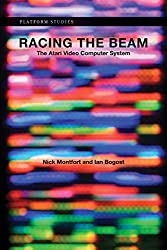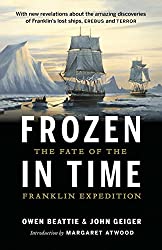
Rating: 8.0/10.
Racing the Beam: The Atari Video Computer System by Nick Montfort and Ian Bogost
Book about the Atari VCS (later renamed the Atari 2600), the first widely sold home video gaming console. At first, Atari developed the games themselves, but eventually, they created a platform that allowed third-party developers to release games on a set of fixed hardware and controls, supporting interchangeable cartridges. The founder, Bushnell, had experience in parlor and arcade games and wanted to bring them to people’s homes while minimizing the cost by connecting the console to the TV. The book tells the story of the Atari 2600 console and technical capabilities through six influential games as case studies.
Developing games for the Atari 2600 was often a herculean feat, with the technical limitations making what are relatively simple tasks now quite complex. The console only had 128 bytes of RAM and 4KB of ROM. The title “Racing the Beam” describes the process of writing code that carefully keeps in sync with the CRT beam which draws one line at a time; you must carefully time instructions and count clock cycles to stay synchronized with the CRT beam, to avoid graphics errors. When the CRT reached the bottom of the screen and began to reposition back to the top, the program had time to handle game logic and inputs.
One of the earliest games for the Atari 2600 was Combat, which featured two-player modes where tanks or airplanes shot at each other, and had several different modes to increase variation. Often you didn’t have a friend to play though, which made Combat quite boring; another classic game, Pong, had some basic AI for one-player mode. It was easy to make the AI play perfectly, but wasn’t very fun, instead, developers made the AI slightly handicapped to give players a chance to win and make the game more enjoyable.
While games like Combat and Pong fit entirely on one screen, Adventure was different: it created a virtual space that was larger than the screen, and was inspired by a text-based game that explored dungeons through text. One technical challenge was positioning objects horizontally, as the hardware was only precise vertically. This required some hacks and timing instructions to get objects to appear in the right place. Interestingly, the programmer, Robinett, left an Easter egg in the game – his own name in the middle of a secret room. At the time, there was no team developing the game; instead, a single developer was hired to write the whole thing and hand it over to the company, but they received no credit nor royalties, which led some talented programmers to quit Atari and start Activision.
Pac-Man was an attempt to port a popular Japanese arcade game to the Atari 2600, but the console’s technical limitations made it difficult to replicate the experience. Still the company acquired the rights and rushed out a port in just a few weeks. One of the biggest issues was that the 2600 only had two sprite registers, which limited it to only being able to draw two sprites on the same horizontal line. To work around this issue, developers used flickering where different ghosts would flicker in and out, but this was an annoying experience for players, and it was difficult to distinguish between the ghosts, making the game much less enjoyable than the original arcade version. In the end, although Pac-Man sold a lot of copies, the reviews were overwhelmingly negative. Combined with other poor releases, such as ET (commonly considered the worst game of all time), led to the video game crash of 1983, and severely damaged confidence in the Atari company and platform.
Despite all the technical limitations, programmers found innovative ways to make interesting games with the limited amount of memory and ROM available. For example, Yars’ Revenge had a complex set of mechanics with multiple ways to kill the enemy, they assumed the players would read the manual to understand how the game worked as the game itself provided very little instruction. However, the technical limitations meant that the engineers always worked alone since they needed to use many hacks and tricks to save on memory, which made it challenging for teams of programmers to collaborate. For example, the sprites sometimes overlapped and used the same bytes as the game’s code logic. In the middle part of the screen in Yars’ Revenge, random looking shield was actually the game source code itself. Another game called Pitfall used procedural random generation to create levels that appeared random but remained consistent when the player switched screens.
Atari produced many movie-based games, putting a lot of effort on acquiring licenses to capitalize on popularity of the movie, but often lost focus on the game itself. For example, ET was only developed in five weeks to meet the Christmas market, a business decision that resulted in a subpar game. Overall, the book provides a good overview of the Atari 2600: it also offers a technical overview of the platform, the fixes needed to overcome technical limitations, and how game design was influenced by the platform.



